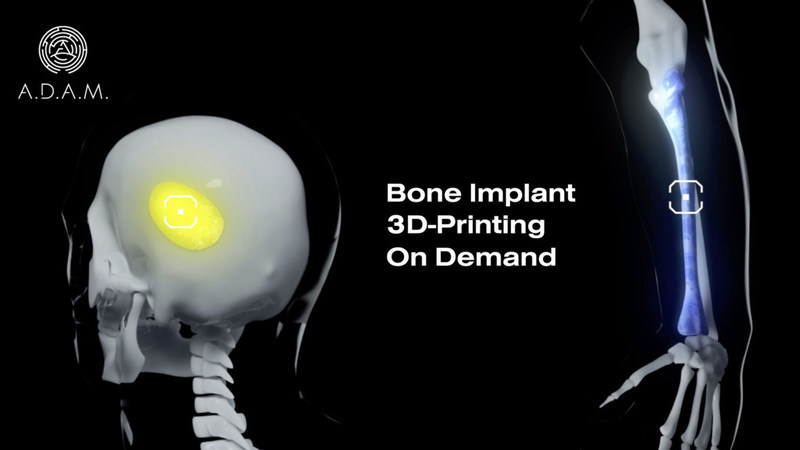Targeting the $50 billion orthopedic implant market, biotech startup A.D.A.M. (short for Advanced Development of Additive Manufacturing) launched an equity crowdfunding campaign on StartEngine that has so far accumulated $122,298 from 119 investors. Focused on developing proprietary 3D printing technologies to make on-demand personalized implants, A.D.A.M. has identified potential growth opportunities in the orthopedic surgery, oncology, craniomaxillofacial, and plastic surgery markets. Although it is still too early to talk about the disruptive effect of the startup, especially since it is still in a research and development stage, A.D.A.M. is now working out of the University of Connecticut’s Technology Incubation Program, has announced an upcoming partnership with “a prominent innovative hospital,” and expects to get FDA clearance for its biopolymer and bioceramic bone implants by 2022.
Founded in 2018 by New York ceramic 3D printing company, Kwambio, and Estonian early-stage venture capital firm WeFund Ventures, A.D.A.M. began its journey developing proprietary technology to 3D print different tissues (initially bones), made of organic materials, to be scalably and affordably produced and used. Even though A.D.A.M.’s machines––which so far include a binder jetting printer (BJP) and a Fused Filament Fabrication (FFF) printing platform––have yet to be revealed to the public, the company claims its already printing flat bone implants from ceramic bio-glass and modified biopolymers to make tubular bone implants.
Thus far, A.D.A.M. has developed a minimum viable product (MVP) for its printer, materials, and digital platform, with just enough features to be used in-house or by early customers, like Yale University’s Professor and Vice-Chair for Research at the Department of Orthopaedics Dr. Mark Horowitz, who is also part of A.D.A.M.’s advisory board. Eager to implement a full scope solution, the company says it will help patients, and healthcare providers model tissues––using the MRI and CAT scans stored in A.D.A.M.’s digital platform––and, subsequently, 3D print and implant them in certified clinics.
Like other firms competing in this field, A.D.A.M. hopes to provide its services either remotely or on-site. Furthermore, the company is betting on an ultra-fast production time and lower production costs, delivered in under three days. This would be a considerable advantage compared to traditional titanium or PEEK-based implants, which are costly, have long delivery times, and are rarely personalized to the needs of the patients. In addition, the company’s biodegradable material for bone implants is expected to help increase patient recovery, with no need for reoperation to extract implant elements since the material itself can stimulate osteogenesis and become entirely replaced by the bone tissue over time.
A.D.A.M. engineer Oleg Rogankov working with the startup’s proprietary 3D printing technology. Image courtesy of A.D.A.M. via LinkedIn.
Following up on its expansion strategy, in 2020, the FDA confirmed A.D.A.M.’s 510 (k) clearance eligibility for its 3D printed bioceramic and modified biopolymer bone implants. Since no human trials are required for the products, the plan is to complete the animal studies needed by the FDA in 2022 at the University of Connecticut, with clearance ideally expected in late 2022 or early 2023.
Commenting on the clearance, A.D.A.M. CEO Denys Gurak stated that the FDA’s response means a significant reduction in the time to market the product, from five to 1.5 years, since only animal trials are required.
Seeking to further expand and accelerate its implant production technology and, in turn, disrupt the orthopedic implants market, A.D.A.M. is onto its second funding round after having raised $500,000 in April 2021. According to StartEngine, the new crowdfunding campaign has exceeded its minimum funding goal and will continue to accept investments until its indicated closing date. At a pre-money valuation of $30.8 million, the company is offering investors shares of Series A preferred stock at $2.93 per share.
“Anyone can invest for as little as $293!,” says Gurak. “We are excited to offer every person, who believes in a future where advanced healthcare solutions should be affordable and who wants to be a part of that future, to become a shareholder of our company. We are building an on-demand personalized tissue manufacturing platform that would be a one-stop-shop for transplanted tissues and organs; and, hence, to cut barriers to medical treatment for millions.”
Equity crowdfunding is becoming quite a trend worldwide, and the 3D printing industry is also catching on. In fact, just last week, we learned that Spain’s pioneering bioprinting firm Regemat is about to launch an equity crowdfunding campaign. Furthermore, according to Forbes, the “meteoric rise of equity crowdfunding” shows no sign of slowing down and is predicted to grow by nearly $200 billion in 2025. Equity crowdfunding has emerged as a market for founders that can raise money from their close network and a mass number of investors in return for an equity share in the business.
With bones being the primary focus at A.D.A.M., the company has attracted a lot of attention, especially with promises of implants made quicker, easier, and cost less. However, long-term company goals are even broader, with plans to launch R&D of blood vessel implants, heart valves, and bronchial implants.
